In 2021, I raised $18,507 on CrowdSupply to manufacture and sell the BusKill cable. This article will review my experience working with Crowd Supply.
Introduction
So you have a great idea for a cool product, but you’re not sure how to scrap up the necessary funds to ramp-up production and sell it? If you’re a traditional capitalist then you’d be considering financing your new entrepreneurial venture through loans or venture capital.
But you’re not a capitalist. You want to avoid the fat cats draining equity from your hard labor. Your idea is so cool, why not try your hand at crowdfunding direct from your soon-to-be customers?
Why Crowd Supply?
The first place I looked was Kickstarter. But I did some googling, and I saw so many people complain that they backed a project on kickstarter and never received anything from the creator. In fact, Kickstarter’s own Fulfillment Report says that 9% of all their projects fail to deliver.
And, especially in the computer security department, if anyone with half a brain scans through the projects on kickstarter, even the ones that raise $1 million scream SCAM! Either their promises are unrealistic, they clearly have no idea what they’re talking about, or they’re selling you something that’s already on the market — with a fancy box and double the pricetag.
The second place I looked was Indiegogo, but because my company is registered in Estonia it was a deal beaker at the time. This point aside, I do highly recommend setting-up a company in Estonia, but that’s an article for another day…
There are loads of other crowd funding platforms, but the next one I checked-out was Crowd Supply. And I’m very glad I did!
For starters, their Proclamation of User Rights is amazing. As a open-source software & hardware creator, this was strongly aligned with my company’s mission to bring innovative, open-source, easy-to-use, security-related hardware to market.
They’re also based in Portland. Weather aside, Portland is a pretty rad place.
Disclaimer
As I used their platform to raise funds for my project, I currently have a business relationship with Crowd Supply. Crowd Supply’s parent company Mouser is a major wholesale customer and distributor of my product.
Prior to my crowdfunding campaign for BusKill, I had no prior relationship with Crowd Supply nor Mouser (business or otherwise).
I’m writing this article because, before I signed a contract with Crowd Supply, I did a lot of googling about “Crowd Supply”, but I couldn’t find many useful reviews. So I wanted to provide my experience to other creators who are considering kickstarting a project on Crowd Supply. I’m receiving no compensation for this article.
Who is Crowd Supply?
Crowd Supply was founded by Lou Doctor in 2012. But you probably won’t speak with Lou (I’m not even sure he still works for Crowd Supply).
In 2022, The current CEO of Crowd Supply is Josh Lifton. Currently Crowd Supply is a fairly small company (I think about a dozen employees). Depending on the difficult questions you ask in your campaign, you may have some interaction with Josh.
In 2012, The company’s creation was a response to all the scams festering on Kickstarter, and Kickstarter’s lack of desire to focus on hardware products. In response to Kickstarter is Not a Store, Crowd Supply published Crowd Supply Is a Store in early 2013.
In 2014, Crowd Supply had breakthrough success. In January, Andrew Huang (bunnie) published an article to makezine.com about Novena, the open-source laptop project. Josh Lifton called bunnie and convinced him to crowdfund on Crowd Supply if CS handled fulfillment. By May they raised over $700,000.
With roots in privacy-focused, open-source hardware, I was feeling pretty good about launching BusKill on Crowd Supply.
The Journey
You better clear your schedule. If you have another full-time job, then prepare for some long nights, weekends, and 70-80+ hour-weeks.
I’ll go into more detail below, but here’s a quick timeline of the journey to bring our product from idea to reality:
| Date | Event |
| 2021-06-12 | We first contacted Crowd Supply |
| 2021-06-14 | Our project is accepted by Crowd Supply (email from Helen) |
| 2021-06-17 | We sign SoW |
| 2021-06-17 | Crowd Supply creates private GitHub repo |
| 2021-06-17 | (Batch 1) We’re assigned 6 GitHub issues by “project-initializer” bot |
| 2021-06-22 | First contact with our Prelaunch Project Manager (Claire) |
| 2021-06-22 | Prelaunch page is live | 2021-08-18 | (Batch 2) We’re assigned 7 new GitHub issues by “project-initializer” bot | 2021-08-18 | We’re assigned a Campaign Launch Project Manager (Chris) | 2021-08-23 | Artist commissioned for explainer video | 2021-12-10 | Explainer video is finished |
| 2021-12-14 | (Batch 3) We’re assigned 7 new GitHub issues by “project-initializer” bot |
| 2021-12-14 | Crowdfunding Campaign is live! |
| 2022-01-14 | Helen hosts me on Crowd Supply’s Teardown Sessions (Ep 17) |
| 2022-01-20 | (Batch 4) We’re assigned 1 new GitHub issue by “project-initializer” bot |
| 2022-01-25 | Crowdfunding Campaign Ends |
| 2022-02-08 | We’re assigned a Post-Campaign Project Manager (Kelly) |
| 2022-02-18 | Our bank receives crowdfunding payments |
| 2022-03-03 | Manufacturing begins |
| 2022-06-11 | Manufacturing complete |
| 2022-07-07 | We receive our first finished product for QA |
| 2022-07-31 | We ship products to Mouser (freight China->USA) |
| 2022-09-21 | Products arrive to Mouser |
| 2022-10-01 | Mouser begins shipping products to customers |
| 2022-10-18 | (Batch 5) We’re assigned 2 new GitHub issue by “project-initializer” bot |
Step 0: Getting Accepted by Crowd Supply
A couple facts:
- Fact: Crowd Supply rejects over 90% of project submissions
- Fact: 100% of Crowd Supply’s projects followed-through and delivered the product to their backers (so far as of 2022)
The above two facts go hand-in-glove. The reality is that Crowd Supply is very picky, and — because of this — they’re very trustworthy.
I worked on my product under lockdown and as a side-project for almost two whole years before I submitted it to them on 2021-06-12. I was quite concerned that they would reject me, but extremely elated when my project was accepted two days later!
Here’s probably why I was accepted (and what you should advertise when you apply). I had:
- A simple video demo showing a fully functional prototype
- Software already on GitHub clearly licensed open-source (GPLv3)
- Extensive hardware documentation already on GitHub clearly licensed open-source (CC-BY-SA)
- Press coverage
- A (small) community of folks that contributed to the project
- Some suppliers ready to begin manufacturing of the more difficult components
I applied to Crowd Supply on June 12th 2022 (Saturday). On Monday my project was accepted, and I was sent a SoW (Statement of Work). After some questions asked and answered, I signed the SoW Thursday.
The Contract
First thing Crowd Supply will do is send you a Statement of Work contract. The good news is that you don’t pay Crowd Supply any fee for launching with them (if you raise $0, then you pay Crowd Supply nothing). The bad news is that they take a large cut (both percent and flat fees per item sold) out of your sales.
I guess every contract may be different, but mine stated:
- Crowd Funding Fee – Crowd Supply gets 12% of all funds raised during the crowdfunding campaign
- Payment Processing Fee – Crowd Supply further deducts 2.9% of all sales for “payment processing”
- Item Fee – Crowd Supply gets an addtional $18 from every item sold. This covers things like free international shipping (it’s less if you don’t offer free international shipping).
My understanding is that the percent fee at the top is negotiable depending on how much hand-holding you require. Since I knew my product but almost nothing about actually fulfilling orders, I didn’t attempt to negotiate this. I signed it as-is knowing that I would heavily need their assistance.
How to price your product?
Crowd Supply has a whole article on how to Properly Price Your Product. A wise creator once told me “
think of how much you think your product should cost, but double it. Then double it again.”That’s a good start, but once you consider the Crowd Supply fees ($18 per item!), you may need to bump it up a bit higher.
I went into my campaign thinking a BusKill cable should cost about $20. But that’s really only possible when producing at-scale (>10,000 pcs). At small scale (< 1,000 pcs), I ended-up selling them for $99.
I was very annoyed by this at the time, but–in hindsight–I’m very happy that I chose this price.
All in all, I launched a pretty successful crowdfunding campaign with a lot of help from Crowd Supply. My prices were higher than I would have liked, but I think their guidance was worth every penny.
The day I sent them the signed SoW, Crowd Supply created a private GitHub repo, invited me, and their project-initializer bot assigned me my first 6 tickets (batch #1). Very streamlined!
Starting with Crowd Supply took from Jun 12 to Jun 17, so it took only 5 days to start batch #1.
Batch 1
After you sign the SoW, you’ll be invited to join a private GitHub repo.
The process is pretty streamlined. A bot will have already created a half-dozen tickets for you. The tickets will ask you to fill-in a bunch of information about your project, which will help them build your Pre-launch page.
You'll be assigned a Project Manager, and all communication will be done through GitHub issues. Fill out the requested information and/or ask questions, then assign the ticket to the PM. Eventually, once all this work is done, your PM will create a Pre-launch page for you on crowdsupply.com
They will also send out an email to their Crowd Supply Newsletter about your project. This is actually really important. At the time of writing, there’s 70,000+ subscribers to this newsletter. It’s full of makers, geeks, hackers, engineers, and journalists. Basically, it’s a bullhorn announcing your upcoming campaign to the best candidate customers you could ask for. If your campaign looks interesting, you’ll already get covered in the press at this stage. My product’s prelaunch was featured on the Electromaker Show, episode 55
Honestly, the marketing value of announcing your product launch on Crowd Supply’s Newsletter is reason enough to crowdfund on Crowd Supply. It’s an enormous spotlight on your work.
Batch #1 went from Jun 17 to Aug 18, so batch #1 was 62 days long
Batch 2: Pre-Launch
After your Pre-launch page is live, you’ll get a whole new wave of tickets. This time you’ll be preparing for the actual campaign.
I got stuck in this stage for quite some time going back-and-forth with an animator I commissioned to create the product’s explainer video. In the end, I think the video turned-out great. But it took 109 days for them to complete a video that was estimated to take 16 days.
Delays, Delays, Delays
One takeaway I had from this whole experience is that you should never rely on your suppliers to delver on-time.
No matter what ETA they give you, you should expect it to take 3-7x times longer than what they say.
Batch #2 went from Aug 18 to Dec 14, so batch #2 was 118 days long.
Batch 3: Live Campaign
Batch #3 is super high-intensity. You want to make sure you’re prepared before you enter this stage.
This is when your campaign goes live and starts a 6-week period where you’re raising funds from potential customers (called “backers” in CS terms).
This is your time to shine. You’ll be on the frontpage of Crowd Supply. They’ll blast an email to their 70,0000 newsletter subscribers about your campaign’s launch. You’ll probably get coverage in at least one podcast and popular syndicates that cover cool crowdfunding tech projects. If you’re lucky, you’ll get interviews with reporters and have coverage in major tech press outlets.
You’ll also want to be extremely active on social media. And publish a significant marketing release at least once per week. I spent over a year drafting marketing content in preparation for this campaign. Here’s what I published for each of the 6-weeks:
- Week 1: BusKill Onion Service
- Week 2: LUKS Header Shredder (BusKill Self-Destruct Trigger)
- Week 3: A Laptop Kill Cord for QubesOS
- Week 4: Quicker Emergency Shutdown for TAILS
- Week 5: BusKill Cross-Platform Video Demo (Windows, MacOS, Linux, TAILS, QubesOS)
- Week 6: BusKill Warrant Canary #3
Our goals with these marketing campaigns were to show-off the novelty of our project, inspire confidence in our legitimacy (that we’re not just a fly-by-night marketing idea with vaporware), and to reach out to specific communities that we believe would be interested in (and talk about) our campaign.
Also in the middle of the campaign, Helen Leigh hosted me on Episode 17 of Crowd Supply’s Teardown Sessions. The video was livestreamed and had several viewers watching live, asking questions about the project. And, before & after the call, I pounced at the opportunity to actually speak with someone at Crowd Supply (sorry Helen!). Actually, this was the only time I’ve ever had a video call with anyone at Crowd Supply, and I learned so much useful information about crowdfunding on Crowd Supply during my barrage of questions before our interview (thanks Helen!)
The campaign in batch #3 lasts 6-weeks (Dec 14 to Jan 25), but I was already issued tickets for batch #4 on Jan 20. So batch #3 was 37 days long.
Batch 4: Post-Campaign
After your campaign ends (assuming you were successful in meeting your minimum funding goal), you’ll finally be able to begin the process of manufacturing your product, putting it in a box, and shipping it in-bulk to Mouser (where they will add it to their inventory and handle fulfillment to your customers for you).
Most importantly, after your campaign ends, Mouser will send you the money you raised–allowing you to finally put-in orders for your first production run!
In our case, we raised 18,507 USD from 264 products ordered. That number includes 150 products ordered by Mouser, which was offered at reduced wholesale pricing (as negotiated throughout batches #1-3 above).
After all fees, Mouser sent a single ACH transfer of 15,017 USD.
As our company is based in the EU, we used Wise to transfer the money to our actual bank account. In the end, we got a SEPA deposit of 13,151 EUR on 2022-02-18 (24 days after the campaign ended).
We also experienced a lot of delays in this batch period:
- COVID-19 Outbreak in Shenzhen (government-enforced lockdown and factory closures)
- 19 National Holidays in China
- Issues with shipping QA to Sweden (Yanwen wouldn’t take the address; changed providers to YunExpress)
- Manufacturing estimate for magnetic breakaway component was 25-30 days. Actually took 100 days.
- US Customs held our shipment on entry for 31 days pending an “intense exam“
It’s also worth noting that (due to rising material costs probably related to the COVID-19 pandemic), the price of raw materials nearly doubled to manufacture our magnetic breakaway component (between the time that we were getting quotes before the campaign to the time where we actually put-in the manufacturing orders after the campaign). Yet another reason it’s better to be conservative in your pricing and make sure you don’t set the price of your product too low!
Batch #4 went from Jan 19 to Oct 18, so batch #4 was 272 days long.
Batch 5: Post-Fulfillment
A couple weeks after your last product is shipped to your last backer, Crowd Supply will assign you a couple more tickets, check their stock (which will hopefully have been going down, eating into Mouser’s wholesale order quantity by so-called “pre-orders” made by customers since your live campaign ended), and update your project page on crowdsupply.org to say that new orders will now ship “within three business days”.
Of course, because Crowd Supply Is A Store, Batch #5 never actually ends. As long as you have customers clicking that “buy” button, you’ll have
- Interactions with customers asking technical and customer support questions
- Project updates to keep customers informed on your continued development
- Future wholesale fulfillment (as Mouser buys from you again to replenish their stock)
- etc
The Finances
So you want to know how profitable we were? First, let me say that we went into this campaign with a $1 minimum fundraising goal. That is to say: we weren’t prioritizing profits.
Our primary goal in this crowdfunding campaign was accessibility. I had a prototype in my hands that could help vulnerable journalists & activists around-the-globe, but the people who needed it couldn’t buy it. My goal with this campaign was to lower the barrier-of-entry for anyone anywhere in the world to be able to buy or build a BusKill cable so that they could protect themselves, their colleagues, and their loved ones.
With that, our secondary goal was to be at least profitable enough to keep the ball rolling. To keep warehouses in-stock. To keep software development going. And to be able to get enough profit to re-invest it in future hardware development for a v2 design.
That said, if I’m honest, I was pretty much just expecting to barely break-even (with my labor unpaid).
Pre-Campaign Expenses
Before we even contacted Crowd Supply, we registered a company in Estonia. That had fees. We opened a bank account. We took out a couple (small) loans. We reached-out to suppliers. We got quotes & samples. And we paid one supplier for them to CNC an injection mold and make a jig for mass production.
All said, we spent a total of -2,889 EUR before the campaign started.
Campaign Fundraising
As described above, in the end, we got a lump-sum payment of +13,151 EUR out of the crowdfunding campaign on Crowd Supply.
Post-Campaign Expenses
After the campaign ended, we paid many suppliers for components. This doesn’t just include the hardware. You also need to consider things like certification fees, product boxes, cardstock paper for documentation inserts, printing fees, artist commissions, packaging materials, warehousing, shipping, and other logistics fees.
All-in-all, we spent a total of -7,154 EUR after the campaign to actually deliver to our customers.
Wages for services rendered
So when we finally had delivered to our customers, we made a profit of +3,108 EUR!
But I should mention that, other than paying artist commissions for marketing materials and fees rendered to Manufactures, Crowd Supply, 3PL providers, etc — I actually didn’t pay myself anything.
It’s hard to be precise, but I estimate that I personally put-in at least 4,720 hours into this project from the time I had the idea of the first prototype to the time that we delivered to all of our backers.
Even if I were to give myself 100% of the money in our company’s bank account as wages for services rendered over the course of this project, I’d be paying myself ~0.66 EUR/hour. But, in-fact, I won’t be doing that–because my primary goal is not profit. My primary goal to make this product available and accessible to those who need it. And I need those funds to pay for our next production run!
But the future is bright. Our product’s sales have been consistent, and Mouser already sent us a Purchase Order for another 250 units! That will allow us to do another production run and continue development. As sales increase and we have a reasonable reserve of dough in the bank (enough to cover one future production run and all yearly operating expenses), then I do plan to pay myself wages for services rendered 🙂
The Struggles
If you’re a creator, you’re hopefully damn good at creating. I knew I could make my product. And I was pretty confident I could market it well. For me, the biggest challenges that I encountered over the course of this crowdfunding project were:
- Forming a company
- Getting a company bank account
- Initial funding for the company
- Accounting
- Integrating a tor-friendly cryptocurrency payment processor into my e-commerce site
- Securely integrating a fiat payment processor into my e-commerce site
- Managing international business relationships through a language barrier
- Balancing [a] quality assurance against [b] long production delays
- Sourcing biodegradable packaging materials
- Nurturing a community of volunteer contributors
- Guesstimating future expenses to determine a reasonable sale price
- Iterating on hardware is slow!
- Shipping samples between China and the EU is slow and expensive
- Trying to estimate actual lead times against what your suppliers tell you
- Ensuring my product complies with regulatory EU Directives, UK Regulations, FCC Requirements, etc, etc
- And …accounting
Generally speaking, my Crowd Supply Project Managers were very helpful in answering my numerous questions. And if they didn’t know the answer themselves, they would ping someone else on the team and bring them into the GitHub issue to try to help me.
Conclusion
Here’s some pros & cons of launching on Crowd Supply
Pros
- Trust. 100% of funded projects have delivered to backers
- Marketing. 70,000+ subscribers to their newsletter
- Passion. They really do care about helping bring open-source hardware to market (over making as much money as possible)
- Guidance. You’ll get support and hand-holding through the very difficult journey ahead.
- Crowdfunding. You’ll be paid before you place your first production run, so you’ll have a better idea of how many to order (eg 80 or 8,000 pcs?)
- Mouser. Crowd Supply doesn’t just act as a vehicle for you to sell to backers. They are your customer. They generally purchase just as many of your products as individual backers, which doubles your sales during the campaign. And they continue to buy large orders from you after.
Cons
- You’ll probably never have a video conference or phone call with anyone at CrowdSupply
- Related to above: I feel like I never really got to “meet” the team at CrowdSupply. You’ll be shifted around between different PMs, and never quite sure who to contact for what.
Overall, I’m very happy to have worked with Crowd Supply in crowdfunding my first hardware product. I have a lot of ideas bouncing around in this noggin, and I would definitely choose Crowd Supply again to crowdfund my next product idea.
My advice to Crowd Supply
That said, I do have advice for Crowd Supply:
- Make it more clear for your creators who they’ll be working with at Crowd Supply and what exactly is the scope of their role on the project & their expertise. My PM changed three times during my project, and I wasn’t sure if this was temporary (or normal). It wasn’t always clear who I should tag and assign tickets.
- At various stages in the campaign’s lifecycle, give your creators the opportunity to have a few ~20-minute Q&A Video Conference calls with their Project Manager so they can check-in and ask questions. The GitHub format is very streamlined and wonderful, but it can’t wholly replace a “real time” voice call.
- Don’t change too much. You’re doing amazing work to help bring open-source hardware to market!
Further Reading
- The Crowd Supply Guide
- Successful Hardware Crowdfunding [on Crowd Supply]: Behind the Scenes by Uri Shaked (raised $3,656 for The Skull CTF)
- Teardown Session 13: behind the scenes at Crowd Supply
- The Anarchist Organic Cookbook for Product Development Presentation by Joshua Lifton (CEO of Crowd Supply)
If you’d like to purchase a BusKill cable, click here.
Related Posts
Hi, I’m Michael Altfield. I write articles about opsec, privacy, and devops ➡
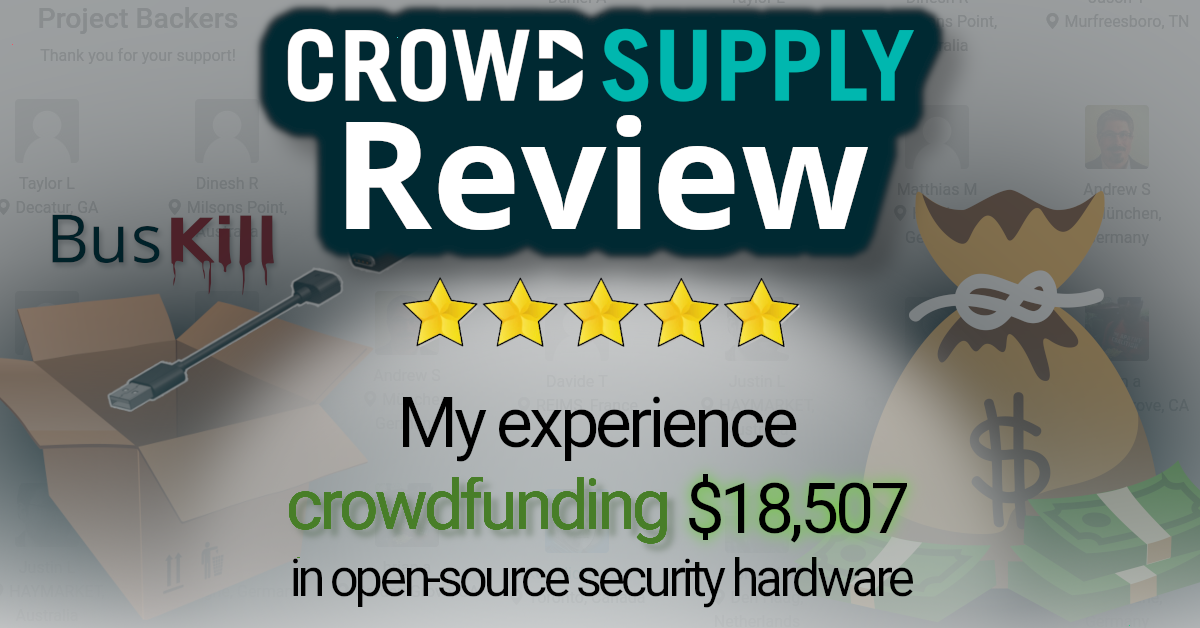


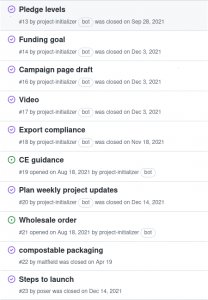
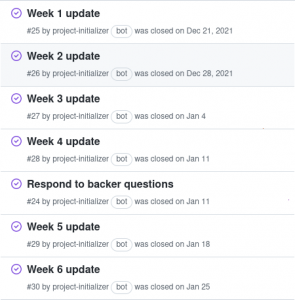
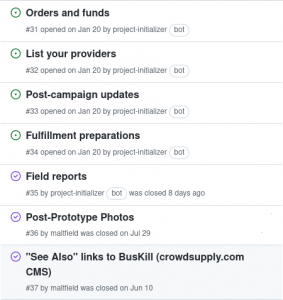

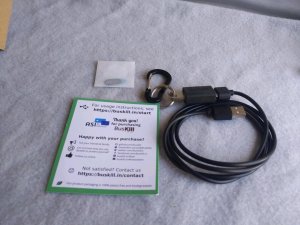
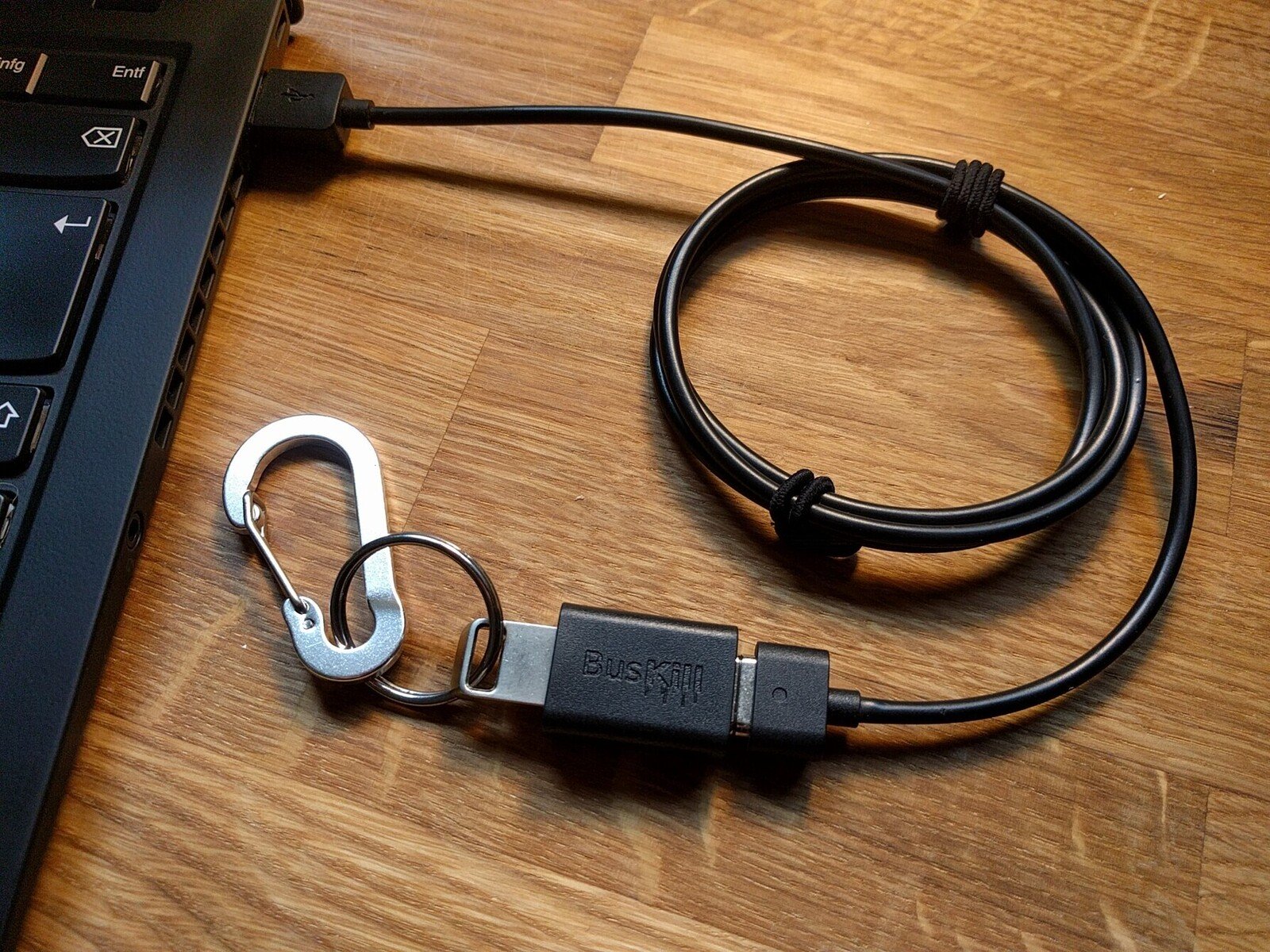






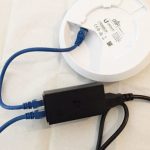






Two questions:
1) Can you give more details about production and china-usa freight? Have they (china manufacture) done tests for you?
2) Can you provide the name of the china manufacturer ?
3) Why you use wise but not just standard bank transfer for money?
Hi Michael,
This is a great article about how to launch a product on crowd supply and you have shared very detailed insights.
I am also working on a product to be launched on crowd supply. Can you share some details on what was the conversion rate? i.e. Subscribers v/s Actual buyers for your first order?
Unfortunately CrowdSupply will not give you those metrics. They won’t even give you the details of your customers, such as their email address and shipping address. The good news is that they handle all of the logistics and customer support for you. The bad is you’re blind on a lot of metrics.
I do remember reading somewhere that suggested crowdfunding generally made one sale for every 1,000 or every 10,000 visitors or something, but I can’t remember the exact figure and I can’t find the source 🙁
In our case, the number of people who subscribed is roughly equal to the number that ordered, which is about 300 people. I suspect that we had at least a million visitors to our Crowd Supply page during the campaign.
Hi Michael,
First of all, congratulations on your project — it looks fantastic, and it’s really inspiring to see open hardware taken that far. I also appreciated your detailed review on your site (tech.michaelaltfield.net) — it was one of the clearest personal accounts I’ve found about working with Crowd Supply.
I’m currently in early talks with them regarding a possible campaign, and I was hoping to ask you a quick question about the Statement of Work (SoW), which you briefly mentioned in your post.
In particular, I’m trying to understand the scope of legal responsibility that Partners take on, especially regarding things that are beyond our direct control (e.g. logistics issues, third-party errors, unexpected fulfillment problems). From what I’ve read, it seems the liability could be quite broad — potentially unlimited — and that’s something I’m trying to get clarity on before moving forward.
If you’re open to sharing how you approached that aspect, or any advice you’d give in hindsight, I’d really appreciate it. I completely understand if you’re busy — even a quick note would be very helpful.
Thanks again for sharing your experience, and congrats once more on your successful launch!
Best regards,
Hi Mariano,
I am not a lawyer, but I would assume that anything that happens before Mouser adds your items to their inventory is your problem. And everything after (logistics from Mouser’s warehouse to the customers) is Mouser’s responsibility.
I recommend opening a ticket on your GitHub with them about this and asking. If they provide some clarity, please do respond to this comment with an update for others. Thanks 🙂
Hi Michael,
Lovely write-up, very informative and much needed since most of the existing ones focus on the other crowdfunding platforms. (Kickstarter, Indiegogo, etc.).
I am currently going through the acceptance process with Crowd Supply. They have accepted my product and have sent over a contract. Most of the terms are reasonable. I am concerned about the Patent Indemnity clause, which says that I will reimburse them for any legal fees that arise out of an infringement claim. Did you have a similar clause? Any thoughts, advise?
Cheers
That seems like a reasonable protection for them to ask. I’m no legal expert, but I would think that launching your product under an LLC should mitigate your own risk. And, of course, make sure all your R&D is published publicly (eg on GitHub) with a copyleft license so it’s obvious that you’ve not violated any copyrights.